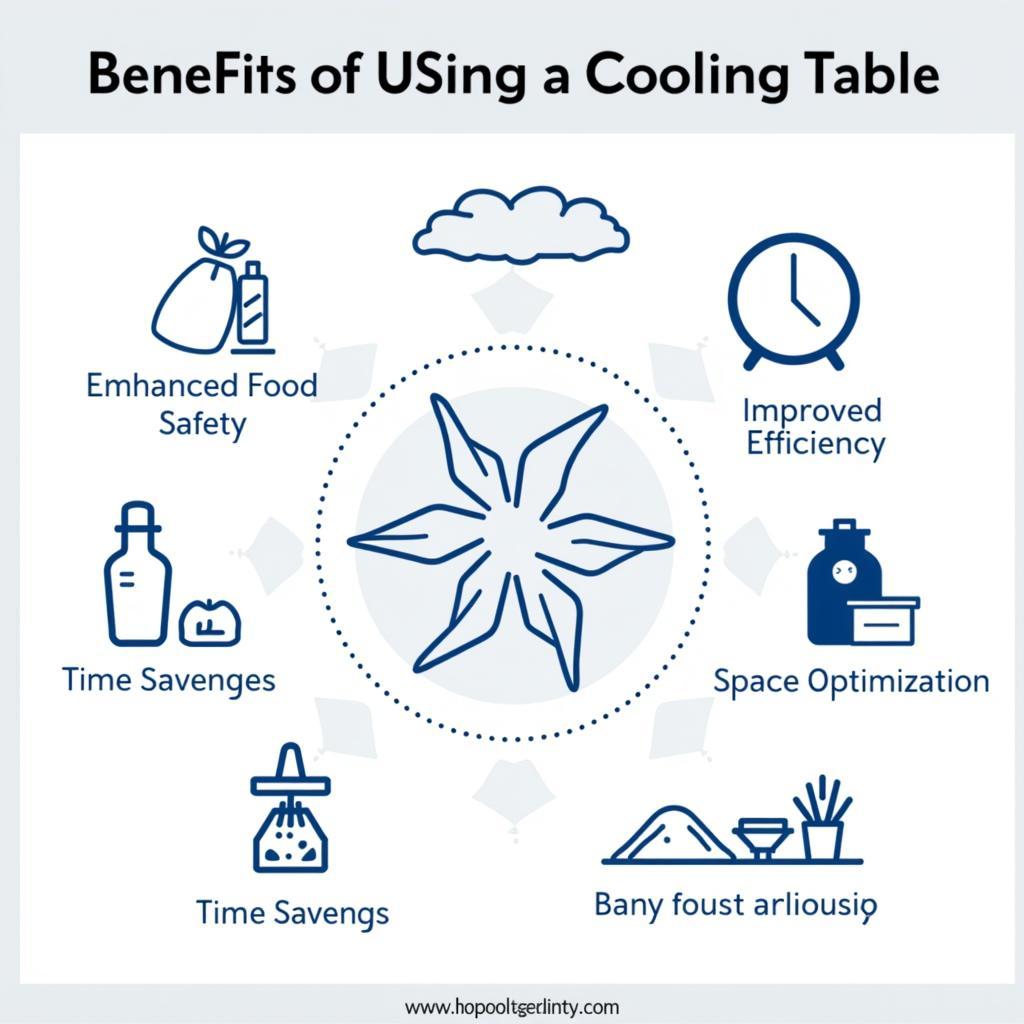A Cooling Table For Food is an essential piece of equipment for any commercial kitchen. It helps to quickly and efficiently cool down cooked food, preventing the growth of harmful bacteria and ensuring food safety. Whether you’re running a restaurant, catering business, or any food service operation, understanding the importance of a cooling table is crucial. This guide delves into the intricacies of cooling tables for food, covering everything from their functionality and benefits to different types and key factors to consider before making a purchase.
Why Use a Cooling Table for Food?
Cooling tables are designed with food safety as the top priority. When food is cooked, it enters a temperature danger zone between 41°F and 135°F (5°C and 57°C) where bacteria thrive. Cooling food quickly through this danger zone is essential to prevent bacterial growth and the risk of foodborne illnesses. Cooling tables expedite this process, ensuring your food remains safe for consumption.
Beyond safety, cooling tables offer numerous benefits:
- Time Efficiency: They cool food significantly faster than traditional methods like ice baths or refrigeration, freeing up valuable kitchen time.
- Space Optimization: Their compact design and multi-tiered shelves allow for cooling large quantities of food in a limited space.
- Improved Food Quality: Rapid cooling helps preserve the texture, flavor, and appearance of your dishes, maintaining their quality.
- Enhanced Organization: Cooling tables often come with features like cutting boards and storage compartments, streamlining your workflow.
Types of Cooling Tables
Various types of cooling tables cater to different needs and kitchen setups:
Blast Chillers:
These are powerful units designed to cool food extremely quickly, reaching a core temperature of 41°F (5°C) or below in 90 minutes or less.
Tumbler Chillers:
Ideal for delicate foods, tumbler chillers gently tumble food while cooling, ensuring even cooling without damage.
Roll-In Chillers:
These large-capacity chillers accommodate rolling racks of food, perfect for high-volume operations.
 Different Types of Food Cooling Tables
Different Types of Food Cooling Tables
Factors to Consider When Choosing a Cooling Table
Selecting the right cooling table is essential for maximizing its benefits. Here are key factors to consider:
1. Capacity: Determine the volume of food you need to cool regularly to choose a table with adequate capacity.
2. Cooling Speed: Consider the types of food you prepare and the required cooling time.
3. Size and Space: Measure your available kitchen space to ensure the cooling table fits comfortably.
4. Features: Explore additional features like adjustable shelves, built-in sinks, or digital temperature controls to enhance functionality.
5. Energy Efficiency: Opt for energy-efficient models to reduce operational costs.
Maintaining Your Cooling Table
Proper maintenance ensures optimal performance and longevity of your cooling table:
- Regular Cleaning: Clean the interior and exterior regularly with food-safe sanitizers.
- Filter Maintenance: Clean or replace air filters according to manufacturer recommendations.
- Temperature Checks: Calibrate and verify the accuracy of the temperature gauge periodically.
- Prompt Repairs: Address any malfunctions or repairs immediately to avoid downtime.
FAQs about Cooling Tables for Food
1. How does a cooling table cool food faster than a regular refrigerator?
Cooling tables utilize powerful fans to circulate cold air rapidly and evenly around the food, accelerating the cooling process compared to the slower, less-efficient air circulation in a standard refrigerator.
2. Can I use a cooling table for storing food long-term?
Cooling tables are designed for rapidly cooling food, not long-term storage. Once cooled, food should be transferred to a refrigerator for proper storage.
3. What types of food can I cool in a cooling table?
Cooling tables are versatile and suitable for cooling various foods, from cooked meats, soups, and sauces to desserts and pastries.
4. How do I calibrate the temperature gauge on my cooling table?
Refer to the manufacturer’s instructions for specific calibration procedures, which usually involve using a calibrated thermometer to compare and adjust the table’s temperature settings.
5. What are some signs that my cooling table requires professional servicing?
Unusual noises, inconsistent cooling, temperature fluctuations, or visible damage to the unit are all indicators that your cooling table may need professional attention.
Investing in Food Safety and Efficiency
A cooling table for food is a smart investment for any food service business serious about food safety, efficiency, and quality. By understanding the different types, features, and maintenance requirements, you can choose the perfect cooling table to streamline your operations and ensure the well-being of your customers.
 Benefits of a Cooling Table for Food
Benefits of a Cooling Table for Food
For inquiries about cooling tables or other food service equipment, contact Mina Cones Food at Phone Number: 02437655121, Email: [email protected] or visit us at 3PGH+8R9, ĐT70A, thôn Trung, Bắc Từ Liêm, Hà Nội, Việt Nam. We’re here to assist you 24/7.